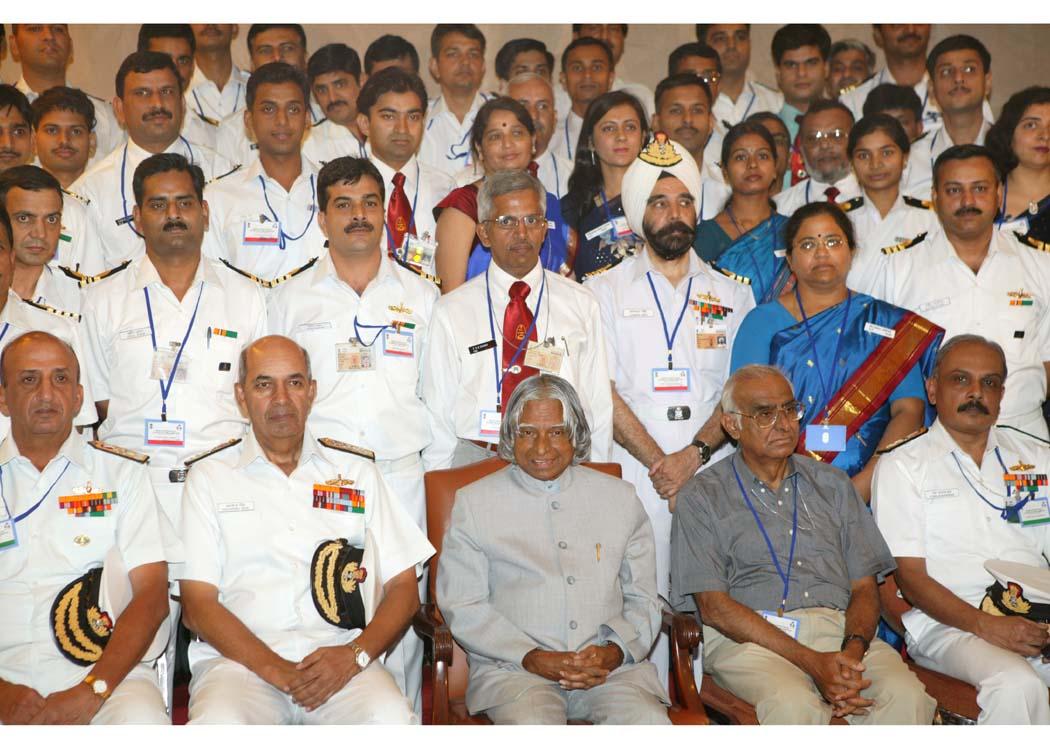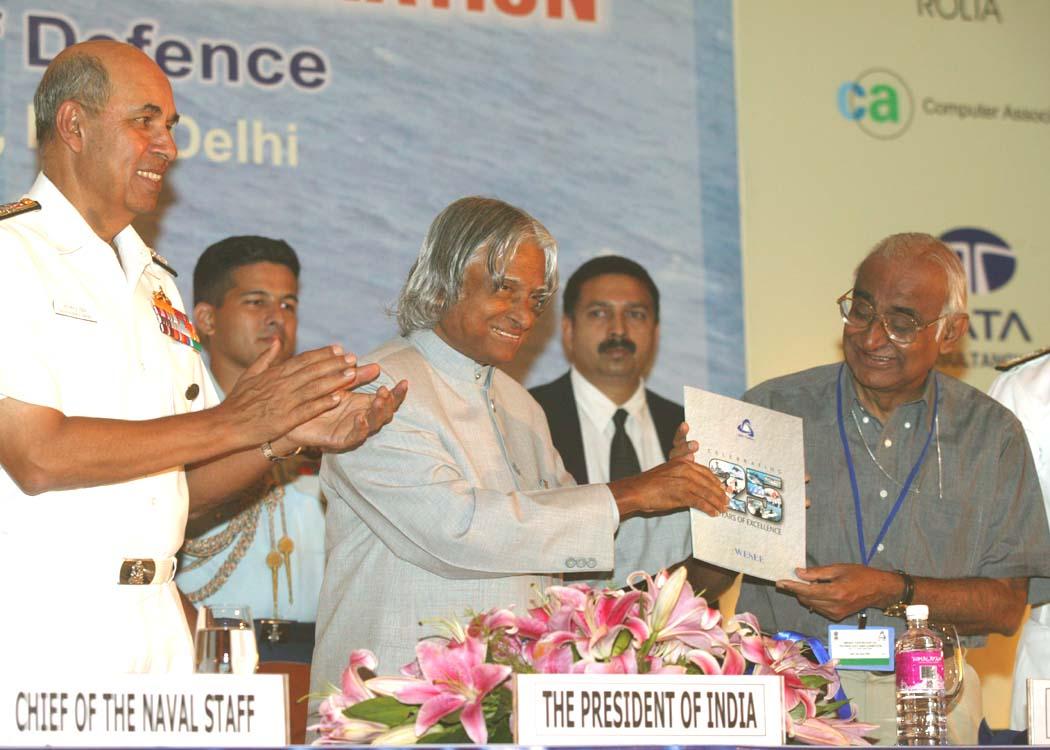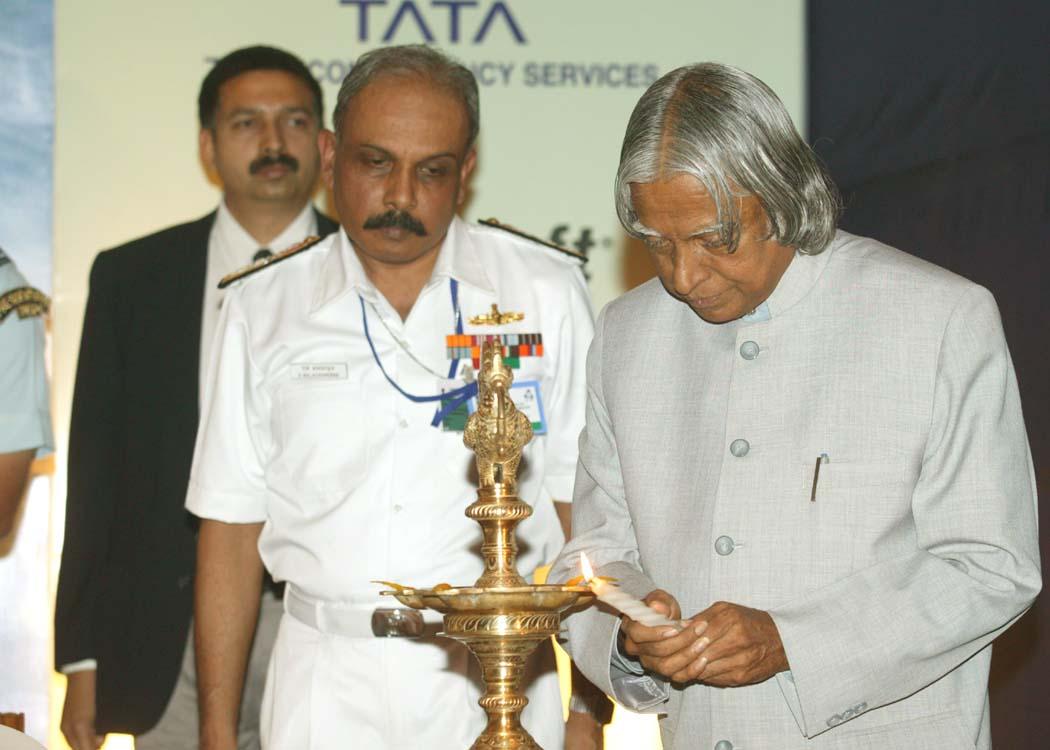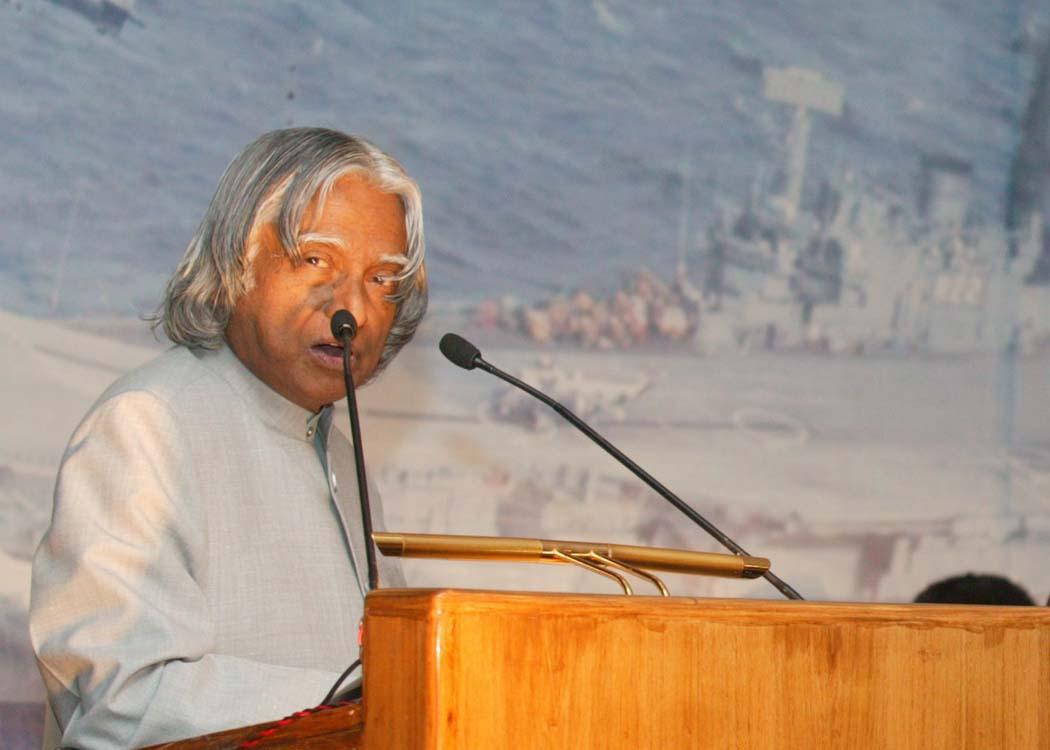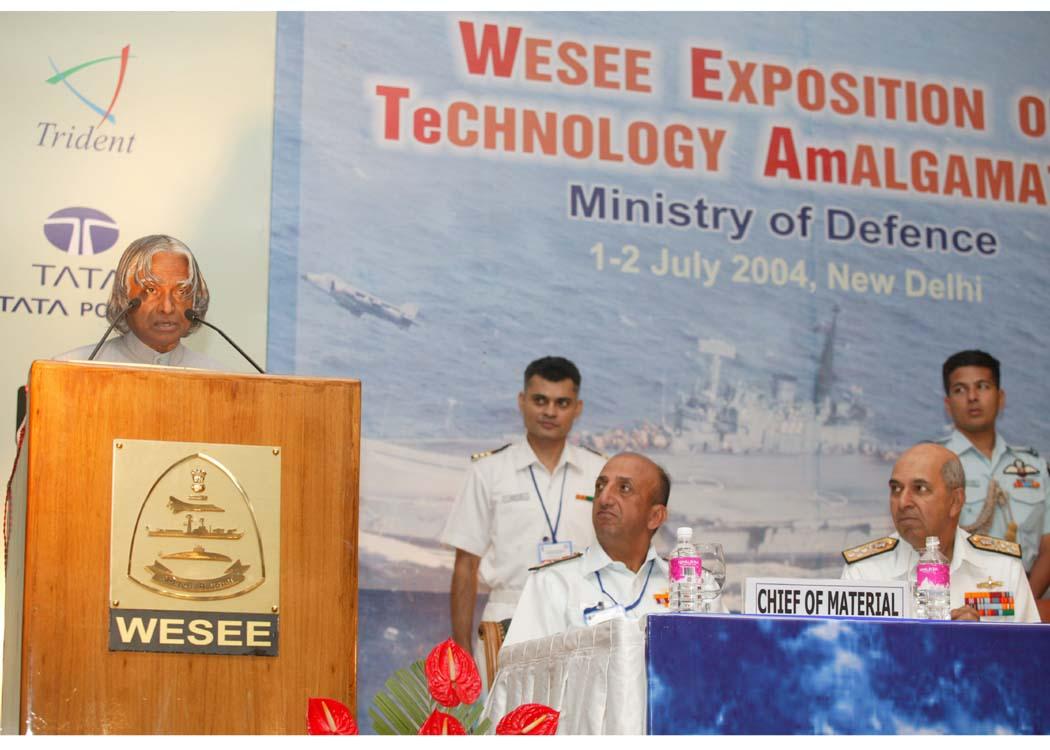Address At The Silver Jubilee Celebrations Of Wesee
New Delhi : 01-07-2004
WESEE towards transformation
I am indeed delighted to participate in the Seminar cum Exhibition to commemorate the Silver Jubilee celebrations of WESEE. It has particularly made important contribution in the areas of Combat system integration of the ship, design and implementation of command and control system, networking and Information Technology and Information Warfare. My greetings to the WESSE team and its partners.
One of the objectives for which WESEE was created was to enable interfacing of diverse weapons and equipments procured from western and eastern agencies on a single platform taking into account variety of input-output characteristics, mutual interference and electro-magnetic compatibility profile. I understand that you have been able to accomplish this mission in full. Now a new situation is emerging due to the availability of Indian platforms and Indian weapon systems. It will put tremendous demand on design and development teams to integrate these systems for optimal performance.
I have been personally involved in the development of many of the defence and space programmes for over 40 years. I would like to share with you what I have learnt during this period. In a development cycle of a missile system or Launch Vehicle systems there are as many as 50 sub systems and more than 100,000 components, during the phase of the development nearly 50% of the time, 5 years out of the 10 years cycle is spent in the development of interface products (Software/Hardware) and above all integration of systems from one end to another and testing nearly consumes 50% of the remaining time (another 5 years). Only in this period design robustness, subsystems reliability and quality are all revealed. One has to systematically handle these issues and find a robust and innovative solution.
You have also contributed significantly in making Navy a fully networked service. WESEE is providing systems integration solutions for the Navy?s ship building programmes, developed and deployed the Nation?s first indigenous command and control system for a warship platform, developed the data link systems and cryptographic solutions.
Synergy between R&D and Industry
When I think about Industry-Defense partnership, I am reminded of the task, which we undertook in the year 1998 between the Ministry of Defense and Confederation of Indian Industry (CII) to synergies the efforts between private industry and the Ministry of Defense. This initiative was taken at the instance of the Ministry of Defense and CII. As a part of this programme, eight of the DRDO laboratories namely DMRL, LRDE, CAIR, DEBEL, DMSRDE, DFRL, DLJ and CPDC were opened up for collaboration with the private sector enterprises. They were told these laboratories were authorized to interact with the private industries and transfer the technologies, which will be beneficial to the civil industry. The CII arranged visits of the industry leaders to the laboratories for on the spot assessment of task in which they can collaborate. This effort led to transfer 40 technologies to different industries in the areas of oils and greases, nuclear instrumentation, anti-spark alloys, giggly saw and boronising etc. These technologies were provided to more than one industry to have maximum spread of the technology in the country. Such effort did provide certain benefits of knowledge sharing to the industry and enabled DRDO to understand the intricacies of transferring technologies to commercial organizations.
In the seminar, I find that you will be discussing important areas like Net-centric Systems and Solutions, Integration of Technologies for Modern Weapon Platforms, commercial Technologies for Defence Applications, Information security, Software Development etc., which will be of current interest to the navy.
Tele-Battlefield management
I would like to give my recent personal experiences. Rashtrapati Bhavan was connected to Carnegie Mellon University, Pittsburgh, USA through Internet and voice over IP (Internet Protocol) in a low bandwidth configuration. I had an interactive conference in real time with the scientists of CMU on ?Digital library for every panchayat in India?. Also, during this week, I interacted with the scientists from NASA and India attending the Indo-US space congress, at Bangalore from Rashtrapati Bhavan using VSAT. Both these technologies ? the satellite based and Internet based, are complementary to each other and are needed for tele-battlefield management with high encryption. Satellite communication provides one to many connections with easy scalability to many. The Internet based technology is a connection less network and because of its use of IP; it is amenable to even for communicating with small form factor mobile devices. These are good for one to few interactive interactions. When we talk about remote battlefield visual communication, we need to have a combination of intense interaction between the field commanders and the HQ but when it comes to delivery of lectures for training and operational room instruction; technologies for communication of one to many should be available. WESSE should consider implementation of tele-battlefield communication system like that of tele-education between HQ, Ship and other training and peace establishments. This will enable better appreciation of war theatre problem by higher levels of command and ensure timely decisions on operational problems.
Software as Force multiplier
Software is a force multiplier in the integration of weapon systems. In a typical Naval platform, we have various types of sensors like Navigational aids, Sonars and Radars, and several types of weapon systems. In order to effectively use the weapons and sensors on any platform, it is imperative that these be integrated in the most optimum manner to increase the effectiveness of the suite of weapon systems thereby achieving its operational role. Such an effective network of command and control system can only be developed using a fast algorithm. Software embedded in the Systems as well as the Simulators of these systems for testing can later be used as training tools. We have to make certain that we use the latest Software development standards in this pursuit, which will help us to produce quality software, which is maintainable. Software is therefore the heart of all weapon systems integration. Self-reliance in Software should be the endeavor of all professionals working on critical weapon system development.
Future challenges in IT Security
The future challenges in Information Technology include the issues related to software security. When we start using the network for defence applications we have to take into consideration all the pitfalls of a network, which could be the source of high security risks. All possible means available today like Intrusion Detection, Physical Security, Firewall, Anti-Virus Software and access control and also the high level software to be used against possible security breach. It is also essential to ensure that we build systems, which are survivable even under the unforeseen worst-case of attack beyond the security perimeter. Open source codes can easily introduce the users to build security algorithms in the system without the dependence of the proprietary platform. Further the spread of IT, which is also influencing the defence, related applications we should take maximum care to ensure that our solution is unique to protect our own defense security solutions implemented on open platforms. Software maintenance and software upgrade is an important issue for defense. Even though the required software for the equipment could be developed by the private industry, it is essential that the technical know-how and the architecture is fully available with these services for ensuring provision of life time support for the software which may or may not be forthcoming from the trade. Considering all these issues, WESEE should benefit from the emergence of new technologies in the area of warfare. Existing platforms can be upgraded to meet 21st century needs of the services through the use of high-end reliable software systems.
Brahmos and SANGRAHA as force multipliers
After successful completion of series of flight trials of Brahmos supersonic missile and the Integrated testing of Naval Electronic warfare systems - SANGRAHA, I understand that navy intends to induct these systems into the service. This will become a important force multiplier for naval ships and naval aircrafts and submarines; WESSE must visualize the system integration of the future platforms keeping the characteristics of Brahmos missile systems and indigenous integrated electronic warfare systems - SANGRAHA in mind.
Triad of Nano-Bio-Info Technologies
I would like to introduce you to a future technology called Nanotechnology. We believe Nanotechnology is such a new technology that is knocking at the doors. It has wider applications compared to information technology and is likely to touch the common man. It will be the central focus for many technologies to converge and open a large number of applications. The essence of Nanotechnology is the ability to work at the molecular level to create structures with fundamentally new molecular organizations. Potential benefits of Nanotechnology are all pervasive covering fields such as materials and manufacturing, NanoElectronics, computer technology, medicine and healthcare, environment and energy, aeronautics and space, biotechnology and agriculture. We are today at the convergence of Nano, Bio and Information technologies. The world market in 2004 for Nanomaterials, Nano tools, Nano devices and Nano biotechnology put together is expected to be over hundred billion dollars. It has been noticed that the fastest growing area among these is nanobiotechnology, predominantly for the civilian sector.
Carbon Nano tubes and its composites will give rise to super strong, smart and intelligent structures in the field of material science. Molecular switches and circuits along with Nano cell will pave the way for the next generation computers. Ultra dense computer memory coupled with excellent electrical performance will give the society low power, low cost, Nano size and yet faster assemblies. The Nano-computers will find many applications.
Nano technology will influence the strategic sector with Nano satellites, stealth structures, micro & Nano vehicles, smart clothes & shoes and gadgets, Nano electronics, Nano computers, Nano actuators, Nano robots, new type of explosives and sensors for land, sea, air and space systems, revolutionising the total concept of future warfare.
Commercial Technologies for Defence Applications
The concept of COTS has now been in vogue for quite sometime. The R&D in the commercial sector is driving several defence applications specially those in the domain of IT & Communications. Today, it is prudent to develop military applications around commercial technologies, methods and mechanisms and defence technologies. Just like some military applications found dual use in the civilian sector, applications using Nanotechnology may see a total reversal of this trend. The commercial technologies are readily available and should be systematically amalgamated with the defence technologies to arrive at a faster and cheaper defence application development process.
Conclusion:
During the last 25 years WESEE has acquired know-how in the design and development of almost every conceivable interface for ship borne applications. Competence has also been built in the field of system engineering, computers, communications and infrastructure to undertake in-house hardware and software development activities. With this background I would suggest that WESEE should become a system engineering organization for all naval platforms. Also with the growth of indigenous development WESEE should be able to system engineer, the naval platforms based on totally indigenous weapons, sensors and equipments. This will need rigorous modeling, simulation with virtual reality visualization of the platforms with supporting infrastructure. Networking of Defence R&D, Naval institutions and industry will give a force multiplier effect for platform and weapon development and management.
I congratulate WESEE on completing 25 years of professional growth and my best wishes to all the participants in the seminar where lot of issues will be raised for thinking and implementing.
May God Bless You.

